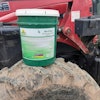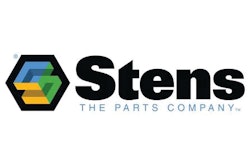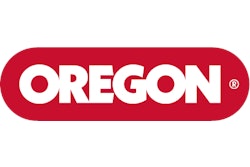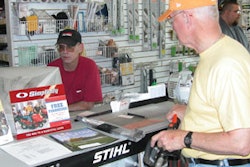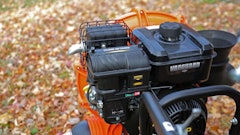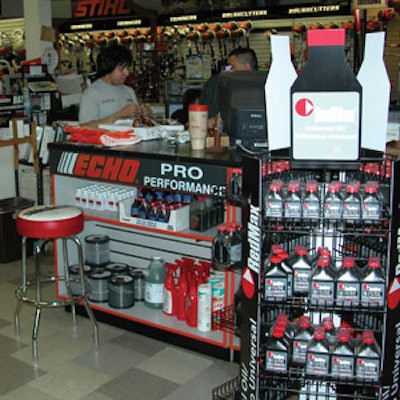
for pushing an add-on sale.
Outdoor power equipment parts and accessories sales have proven to be some of the most profitable. Going beyond merchandising, how can dealers get these add-on sales? It often boils down to really knowing the customer’s needs, and at the most opportune time, presenting the purchase as a convenient and attractive buy.
Achieving the add-on sale is very beneficial to the dealership. These high-margin buys bring in a lot of profit, and when sold with equipment, make that sale even sweeter. “The purchase of equipment and add-on’s goes hand in hand,” says Matt Werner, regional sales rep for Stens. “Dealers make a lot wider margins when they are selling parts, or add-on’s. They are much more incented to find add-on’s and additional parts when selling equipment or servicing equipment because they make a lot more money when they do it.”
TOP BUYS
While there are plenty of parts and accessory options out there for consumer and commercial customers, there are a few that continuously prove to be top sellers. “By far, our top-selling parts are spark plugs, air filters, oil filters and blades,” says Werner. “A lot of that stuff goes together. When a customer brings in equipment for maintenance, these are the things that usually come with it.”
Sometimes, the add-on sale is not a product, but rather a service itself. “The sale can’t only be a part, it can be a service,” explains Jeff Spencer, Oregon technical training specialist for the central U.S. “Dealers can sell equipment servicing or maintenance with the initial purchase.”
As part of the equipment sale, dealers may suggest that the customer pay for maintenance up front, bringing in the equipment after a few months to get it serviced. Service or maintenance may include an oil change or blade sharpening, and a routine check of equipment performance. Stens also offers their dealers a Franzen automated chain-sharpening machine, allowing them to sell sharpening as an add-on service.
INVESTIGATING INDIVIDUAL NEEDS
Knowing the customer’s needs can help greatly in deciding which add-on part or service is right for them. “We like to say you do a fact-find mission,” shares Werner. “The first thing you need to find out is what exactly they are doing with the equipment, whether they are mowing one acre or five acres, because the add-on’s would vary from there.”
The conditions a customer works in will also help determine which add-on’s are right for them. “A consumer isn’t going to change their oil or air filters once a month if they are only mowing four times in that month, where the pro guy has been mowing for 30 days,” Spencer explains further. “You have to really know your customer.”
When talking to customers, listen for key words and topics that signal the possibility for an add-on sale. Knowing the customer’s needs and approaching the customer with the appropriate product or service further guarantees the success of the sale.
Once you know the detail of the customer’s needs, it is the appropriate time to try for the accessory or parts sale. If you have pinned down what they are using the equipment for and to what extent, picking add-on’s that go together in a package deal might make for a larger sale. “Once you have that customer down to what kind of product they want, there are other equipment pieces to go with it as accessories,” says Spencer. Suggest to the customer add-on’s such as another set of blades (more if they are a commercial cutter), and several maintenance items.
“If a person does their own maintenance, you want to make sure they have all those maintenance items ready to go when they leave the shop with their new tractor, Spencer continues. “A month from now, they’ve got all that stuff on hand ready to go.” When discussing the equipment pricing, give the customer a price for the equipment alone and a price for the equipment paired with a package of necessary add-on’s.
THE WHOLE PACKAGE
Stens is currently working on developing pre-made packaged buys for their dealers, to debut in 2009. “We will target specific models that are high box store-moving models or a general model for a Briggs engine that are on many of the push mowers,” explains Werner.
“We plan to include a bottle of oil, spark plug and filter.” Werner went on further to explain that the kits are the ideal point of purchase piece for the customer who has the ability and mechanical know-how to replace a service item.
Spencer also agrees that packaged buys are a great way to push add-on’s, saying, “Bulk product packs tie things together. I think when dealers put packages together that offer air filters, oil filters, pre-cleaners and lawnmower blades, it makes a nice package of all your high-maintenance items.” Many dealers will also offer commercial customers a deal when they buy parts or accessories in bulk for their fleets.
While the packaging makes the sale seem like a good buy, appealing to convenience can also influence a sale. The convenience of having the parts when needed saves time, gas and money. For commercial customers, this can mean a lot to their bottom line.
“If they are in a major metropolitan area and have to drive 50-60 miles, you are talking money spent on gas, and also time,” says Spencer. “Time is money, especially to the pro people. The time saved by already having it there when you need it at the end of the day or workweek when working on equipment is huge.”
SALES INCENTIVES & PROCEDURES
Making the sales attractive to customers won’t help unless selling them is made appealing to employees. Incentives and bonus plans will help encourage employees to aggressively push for add-on sales. Larger dealers may have a sales staff continuously walking the floor talking with customers. Smaller dealers without these resources can still prove successful.
Whether your sales staff is big or small, incentives help to get them going. “The owners know they are making a much a higher margin and bringing in much more cash by selling parts,” shares Werner. “They will incent their sales and service reps to in fact sell or install parts, and they are paid a bonus off that.”
Some advise that instead of focusing on ways to encourage salesmen to try for add-on sales, it should simply be an established part of the dealership’s selling procedure. Salesmen should learn in initial sales training that trying for the add-on sales is a part of any equipment sale. “Dealers should insist that is how they do business,” Spencer says. “Some might consider them add-on’s, but I consider them a part of the sale. We’re not just selling a person a piece of equipment, we’re selling them the parts and service that go with it.”
Once the customer has decided on the right piece of equipment and the appropriate add-on’s, closing the sale in a manner that satisfies the customer and brings them back for more should be the new focal point. “This is an opportunity to let the customer know that you are going to take care of them, by giving them information on backup inventory, parts and service,” says Spencer.
Just providing the customer with the right products from the start can do a lot to influence a customer to return. “If you know that specific person, mowing conditions or cutting conditions, and you sell them something that works or turns out better than anything they have used before, they are going to come back to you because they see that you are an expert.”
In addition to helping them find the right product or add-on, lending your expertise can go a long way. “Dealers are smarter than ever now, and a lot of those who do well are the dealers who give the little tips and hints that maybe just your average man or woman who is mowing their lawn would not know,” says Spencer. “Small tips can make a customer really feel like they are taken care of and can trust the dealer.” Advising the customer on overall equipment operation can help build trust for your services, products and expertise.
Taking the time to get to know a customer and their needs is a vital part of the procedure for pushing an add-on sale. Working to get these high-margin sales means motivating employees with bonus or incentive plans, designing a personal add-on package for the customer based on their individual needs, and executing the sale in a way that deeply pleases the customer.

